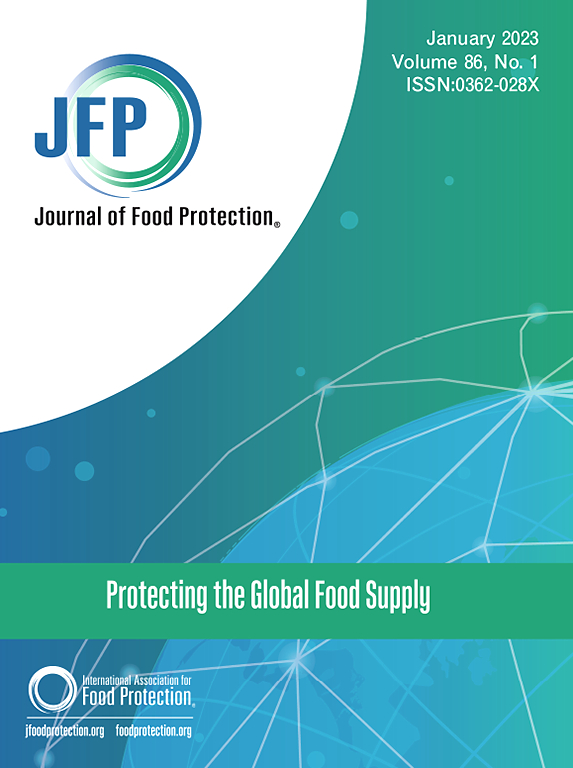Factors Affecting the Adhesion of Flour Particles to Stainless-steel Surfaces and Vacuum Dry-cleaning
IF 2.8
4区 农林科学
Q3 BIOTECHNOLOGY & APPLIED MICROBIOLOGY
引用次数: 0
Abstract
Recent outbreaks and recalls linked to flour-based products have highlighted the need for improved cleaning methods in low-moisture environments. The factors affecting adhesion forces of flour particles, and the vacuum cleaning methodologies to overcome these forces, need to be better understood. The objectives of this study were to: (1) Measure electrostatic charge build-up in flour under different environmental conditions (20, 40, 60% relative humidity at room temperature), (2) quantify how powder size (US standard No. 60–80 or 80–100 mesh), electrostatic charge (charged and uncharged), and relative humidity impact the force required to remove the powder from an electropolished 304 stainless steel coupon (8 × 8 × 0.2 cm), and (3) determine the most effective vacuum nozzle angle (0, 45, 90° relative to the surface) for cleaning. Chargeability (nC) of flour samples was assessed using Faraday cup electrometry, while the surface adhesion force of the flour particles was measured using a custom-built impact tester. The surface cleanliness after vacuum treatments was assessed using ATP (adenosine triphosphate) swabs and a luminometer. Charged flour samples at 20% relative humidity (RH) exhibited a significantly higher charge compared to those at 40 and 60% RH. Within the 60–80 mesh range, charged flour showed higher adhesion rates than uncharged samples at both 20 and 40% RH. However, in the 80–100 mesh range, charged flour did not show a significant difference in adhesion when compared to uncharged samples at any RH level. Additionally, at 60% RH, surface residues measured by ATP were significantly lower for a vacuum angle of 90° than for 0° across both 60–80 mesh and 80–100 mesh size ranges of wheat flour. The vacuum cleaning treatment proved capable of overcoming the increase in adhesion from triboelectric forces; however, trace flour residues were still detected on stainless steel surfaces postvacuuming, indicating that vacuuming alone may be insufficient.
影响面粉颗粒附着在不锈钢表面和真空干洗的因素。
最近发生的与面粉产品有关的疫情和召回事件凸显了在低湿度环境中改进清洁方法的必要性。需要更好地了解影响面粉颗粒附着力的因素以及克服这些附着力的真空清洁方法。本研究的目标是(1) 测量不同环境条件(室温下相对湿度分别为 20%、40%、60%)下面粉中的静电荷积聚情况;(2) 量化粉末大小(美国标准 60 - 80 目或 80 - 100 目)、静电荷(带电和不带电)和相对湿度对从电抛光 304 不锈钢试样(8 × 8 × 0.2 厘米)上去除粉末所需力的影响;(3) 确定最有效的真空清洁喷嘴角度(相对于表面的 0°、45°、90°)。使用法拉第杯电测法评估了面粉样品的荷电性(nC),同时使用定制的冲击力测试仪测量了面粉颗粒的表面附着力。使用 ATP(三磷酸腺苷)棉签和发光仪评估了真空处理后的表面清洁度。相对湿度(RH)为 20% 的带电面粉样品与相对湿度为 40% 和 60% 的样品相比,电荷量明显更高。在 60 - 80 目范围内,相对湿度为 20% 和 40% 时,带电面粉的粘附率均高于不带电的样品。然而,在 80 - 100 目范围内,在任何相对湿度条件下,带电面粉与不带电样品的粘附力都没有明显差异。此外,在 60% 相对湿度条件下,用 ATP 测量的小麦粉表面残留物在 60 - 80 目和 80 - 100 目粒度范围内,真空角 90° 明显低于真空角 0°。事实证明,真空清洁处理能够克服三电作用力导致的附着力增加,但在真空处理后的不锈钢表面仍检测到微量面粉残留,这表明仅靠真空处理可能还不够。
本文章由计算机程序翻译,如有差异,请以英文原文为准。
求助全文
约1分钟内获得全文
求助全文
来源期刊

Journal of food protection
工程技术-生物工程与应用微生物
CiteScore
4.20
自引率
5.00%
发文量
296
审稿时长
2.5 months
期刊介绍:
The Journal of Food Protection® (JFP) is an international, monthly scientific journal in the English language published by the International Association for Food Protection (IAFP). JFP publishes research and review articles on all aspects of food protection and safety. Major emphases of JFP are placed on studies dealing with:
Tracking, detecting (including traditional, molecular, and real-time), inactivating, and controlling food-related hazards, including microorganisms (including antibiotic resistance), microbial (mycotoxins, seafood toxins) and non-microbial toxins (heavy metals, pesticides, veterinary drug residues, migrants from food packaging, and processing contaminants), allergens and pests (insects, rodents) in human food, pet food and animal feed throughout the food chain;
Microbiological food quality and traditional/novel methods to assay microbiological food quality;
Prevention of food-related hazards and food spoilage through food preservatives and thermal/non-thermal processes, including process validation;
Food fermentations and food-related probiotics;
Safe food handling practices during pre-harvest, harvest, post-harvest, distribution and consumption, including food safety education for retailers, foodservice, and consumers;
Risk assessments for food-related hazards;
Economic impact of food-related hazards, foodborne illness, food loss, food spoilage, and adulterated foods;
Food fraud, food authentication, food defense, and foodborne disease outbreak investigations.
 求助内容:
求助内容: 应助结果提醒方式:
应助结果提醒方式:


